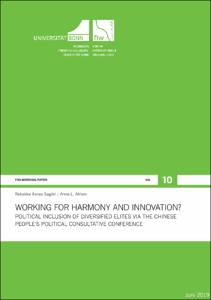Åsnes Sagild, Rebekka; Ahlers, Anna L.: Working for Harmony and Innovation? : Political Inclusion of Diversified Elites via the Chinese People’s Political Consultative Conference. Bonn: Forum Internationale Wissenschaft, 2019. In: FIW Working Paper, 10.
Online-Ausgabe in bonndoc: https://hdl.handle.net/20.500.11811/8469
Online-Ausgabe in bonndoc: https://hdl.handle.net/20.500.11811/8469
@techreport{handle:20.500.11811/8469,
author = {{Rebekka Åsnes Sagild} and {Anna L. Ahlers}},
title = {Working for Harmony and Innovation? : Political Inclusion of Diversified Elites via the Chinese People’s Political Consultative Conference},
publisher = {Forum Internationale Wissenschaft},
year = 2019,
series = {FIW Working Paper},
volume = 10,
note = {This paper describes the fascinating case of the Chinese People’s Political Consultative Conference system (CPPCC) and its evolution since 1949. The CPPCC’s original idea is to allow select members who represent the diversity of society in the one-party state gain limited access to policy-making in exchange for their (public show of) adherence to the Chinese Communist Party (CCP). Usually seen as merely a decorative “flower vase” for the one-party regime, or – at best – as a networking club meant to appease varying elite groups in Chinese society, the CPPCCs represent a largely overlooked part in research on the Chinese political system. Despite the CCP’s fundamental ideological transformations since 1949 it adamantly clings to this symbol of “party-external consultation” and the “Patriotic United Front”, which was recently reinvigorated by the party leadership. Against this background, in this article we trace the major developments in the CPPCC since 1949 and identify both the continuities as well as significant interpretational and practical shifts that have occurred with regard to the CPPCC’s main official functions: “representation” and “consultation”. We have looked, in particular, at official descriptions and legitimations of the CPPCC system, delegates’ self-conceptualization and interpretation of their role, and how all this translates into the conferences’ political practice today. Our preliminary findings show how the CPPCC on the one hand still embodies the CCP’s traditional preference for differential political inclusion, which in this case equates social status with political capability and bets on the cooptation of diversified elites. On the other hand, we observe that the deliberately non-transparent and flexible selection criteria and work guidelines for the CPPCC present both constraints as well as chances for selected members when defining their role and function. Finally, beyond providing an overview of the CPPCC system’s evolution, status, and work mode, we identify the many gaps that still exist in research on this institution and suggest potential starting points for future studies.},
url = {https://hdl.handle.net/20.500.11811/8469}
}
author = {{Rebekka Åsnes Sagild} and {Anna L. Ahlers}},
title = {Working for Harmony and Innovation? : Political Inclusion of Diversified Elites via the Chinese People’s Political Consultative Conference},
publisher = {Forum Internationale Wissenschaft},
year = 2019,
series = {FIW Working Paper},
volume = 10,
note = {This paper describes the fascinating case of the Chinese People’s Political Consultative Conference system (CPPCC) and its evolution since 1949. The CPPCC’s original idea is to allow select members who represent the diversity of society in the one-party state gain limited access to policy-making in exchange for their (public show of) adherence to the Chinese Communist Party (CCP). Usually seen as merely a decorative “flower vase” for the one-party regime, or – at best – as a networking club meant to appease varying elite groups in Chinese society, the CPPCCs represent a largely overlooked part in research on the Chinese political system. Despite the CCP’s fundamental ideological transformations since 1949 it adamantly clings to this symbol of “party-external consultation” and the “Patriotic United Front”, which was recently reinvigorated by the party leadership. Against this background, in this article we trace the major developments in the CPPCC since 1949 and identify both the continuities as well as significant interpretational and practical shifts that have occurred with regard to the CPPCC’s main official functions: “representation” and “consultation”. We have looked, in particular, at official descriptions and legitimations of the CPPCC system, delegates’ self-conceptualization and interpretation of their role, and how all this translates into the conferences’ political practice today. Our preliminary findings show how the CPPCC on the one hand still embodies the CCP’s traditional preference for differential political inclusion, which in this case equates social status with political capability and bets on the cooptation of diversified elites. On the other hand, we observe that the deliberately non-transparent and flexible selection criteria and work guidelines for the CPPCC present both constraints as well as chances for selected members when defining their role and function. Finally, beyond providing an overview of the CPPCC system’s evolution, status, and work mode, we identify the many gaps that still exist in research on this institution and suggest potential starting points for future studies.},
url = {https://hdl.handle.net/20.500.11811/8469}
}






